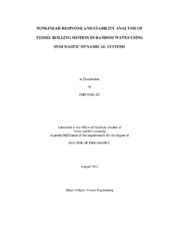| dc.contributor.advisor | Falzarano, Jeffrey M. | |
| dc.creator | Su, Zhiyong | |
| dc.date.accessioned | 2012-10-19T15:30:50Z | |
| dc.date.accessioned | 2012-10-22T18:03:25Z | |
| dc.date.available | 2014-11-03T19:49:14Z | |
| dc.date.created | 2012-08 | |
| dc.date.issued | 2012-10-19 | |
| dc.date.submitted | August 2012 | |
| dc.identifier.uri | https://hdl.handle.net/1969.1/ETD-TAMU-2012-08-11759 | |
| dc.description.abstract | Response and stability of vessel rolling motion with strongly nonlinear softening stiffness will be studied in this dissertation using the methods of stochastic dynamical systems. As one of the most classic stability failure modes of vessel dynamics, large amplitude rolling motion in random beam waves has been studied in the past decades by many different research groups. Due to the strongly nonlinear softening stiffness and the stochastic excitation, there is still no general approach to predict the large amplitude rolling response and capsizing phenomena. We studied the rolling problem respectively using the shaping filter technique, stochastic averaging of the energy envelope and the stochastic Melnikov function. The shaping filter technique introduces some additional Gaussian filter variables to transform Gaussian white noise to colored noise in order to satisfy the Markov properties. In addition, we developed an automatic cumulant neglect tool to predict the response of the high dimensional dynamical system with higher order neglect. However, if the system has any jump phenomena, the cumulant neglect method may fail to predict the true response. The stochastic averaging of the energy envelope and the Melnikov function both have been applied to the rolling problem before, it is our first attempt to apply both approaches to the same vessel and compare their efficiency and capability. The inverse of the mean first passage time based on Markov theory and rate of phase space flux based on the stochastic Melnikov function are defined as two different, but analogous capsizing criteria. The effects of linear and nonlinear damping and wave characteristic frequency are studied to compare these two criteria. Further investigation of the relationship between the Markov and Melnikov based method is needed to explain the difference and similarity between the two capsizing criteria. | en |
| dc.format.mimetype | application/pdf | |
| dc.language.iso | en_US | |
| dc.subject | Stochastic nonlinear dynamics | en |
| dc.subject | Moment Equations | en |
| dc.subject | Cumulant Neglect Method | en |
| dc.subject | Melnikov Function | en |
| dc.subject | Stochastic Averaging | en |
| dc.subject | Vessel Capsizing | en |
| dc.title | Nonlinear Response and Stability Analysis of Vessel Rolling Motion in Random Waves Using Stochastic Dynamical Systems | en |
| dc.type | Thesis | en |
| thesis.degree.department | Civil Engineering | en |
| thesis.degree.discipline | Ocean Engineering | en |
| thesis.degree.grantor | Texas A&M University | en |
| thesis.degree.name | Doctor of Philosophy | en |
| thesis.degree.level | Doctoral | en |
| dc.contributor.committeeMember | Lutes, Loren D. | |
| dc.contributor.committeeMember | Mercier, Richard | |
| dc.contributor.committeeMember | Kim, Moo-Hyun | |
| dc.contributor.committeeMember | Palazzolo, Alan | |
| dc.type.genre | thesis | en |
| dc.type.material | text | en |
| local.embargo.terms | 2014-10-22 | |


